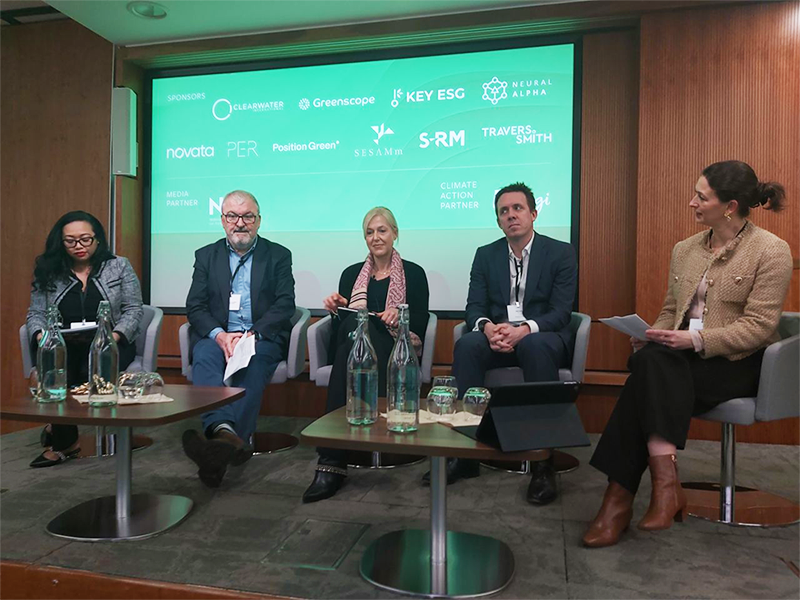The annual ESG conference, co-hosted by Real Deals and The Drawdown, took place in January this year at The King's Fund in London
Rebecca Liebel, Head of Munich and ESG & Sustainability, held an insightful panel titled "The Commerciality of Quantifying ESG: How Integrating ESG Becomes a Core Driver for Value Creation."
The panel featured industry leaders Dörte Höppner, Chief Sustainability Officer at The Riverside Company; Richard Burrett, Chief Sustainability Officer at Earth Capital; Misa Andriamihaja, Private Equity Lead at the Institutional Investors Group on Climate Change (IIGCC); and Matt Smith, Co-Head of Private Equity at Foresight Group.

Quantifying ESG: which are the easiest elements to measure?
In the realm of ESG considerations, there is an increasing focus on the development of approaches to quantify and evaluate a diverse range of ESG metrics. One key challenge is finding tangible measures that accurately reflect the impact of corporate activities on environmental sustainability, social responsibility, and governance practices. The complexity of ESG data necessitates robust tracking mechanisms to provide oversight and ensure companies stay on the right path to create value.
Misa Andriamihaja advocates that climate metrics are relatively easier to measure, and underscores the importance of identifying measurable indicators for comprehensive ESG assessments. One key ESG framework is the IIGCC Net Zero Framework. The objective is to help investors align more of their portfolio with the goals of the Paris Agreement, as set out by their net zero commitments. Under this framework, investors should engage, or classify as aligned, assets that account for 70% of financed emissions in material sectors.
"Employees are thinking about accountability, and want to work in a company with social purpose"
How does commitment to ESG help attract and retain the best team members?
The discussion extends to understanding the intricate linkages between ESG data, material efforts, and value creation. Emphasising the role of ownership and integrating ESG into the fabric of a company, the conversation highlights the idea that a long-term plan and a strong internal culture contribute to value creation.
Employees are thinking about accountability, and want to work in a company with social purpose. The concept of ownership in the workplace is a potent strategy for fostering employee engagement and reducing burnout. Dörte Höppner discussed The Riverside Company’s partnership with Ownership Works and that through advocating that all employees become part owners and receive benefits upon exit, the organisations can cultivate a sense of shared responsibility and alignment of interests.
Dörte has seen this approach encourage a higher level of buy-in from the workforce and enhance overall engagement and commitment. The tangible rewards tied to ownership contribute to increased employee retention, creating a positive cycle that strengthens the organisational culture and the well-being of its workforce.
ESG at different stages of the investment cycle

The value of ESG factors varies across different stages of the investment cycle, with considerations extending beyond financial incentives. In the context of investment culture, particularly in the U.S., there is noted resistance to ESG initiatives, with Dörte indicating the need to instead focus attention on the increased returns and positive value achieved through having ESG mechanisms in place.
Matt Smith underscores the importance of honesty, synergy with value creation, and good business practices in integrating ESG into the investment decision-making process. Furthermore, Richard Burrett from Earth Capital emphasised the dynamic nature of value, where various products generate distinct measurable values linked to sustainability. He argued that value must be broadly defined to encompass diverse aspects, as sustainability factors fluctuate due to events like war or energy crises, reshaping its nature. This encompasses both objective and subjective elements.
The conversation also touches on the evolving nature of ESG metrics, moving beyond simplistic scoring systems.
The need to situate ESG discussions within the investment committee and embed them into all processes is highlighted as a crucial step by Misa and Matt, providing a holistic approach that aims to avoid potential issues associated with separation.
The overall consensus is that for ESG to be effective, it requires authentic backing from CEOs and a full integration into the organisational ethos and processes.
The need to situate ESG discussions within the investment committee and embed them into all processes is highlighted as a crucial step by Misa and Matt, providing a holistic approach that aims to avoid potential issues associated with separation.
The overall consensus is that for ESG to be effective, it requires authentic backing from CEOs and a full integration into the organisational ethos and processes.

Rebecca's profile

Ashalan's profile